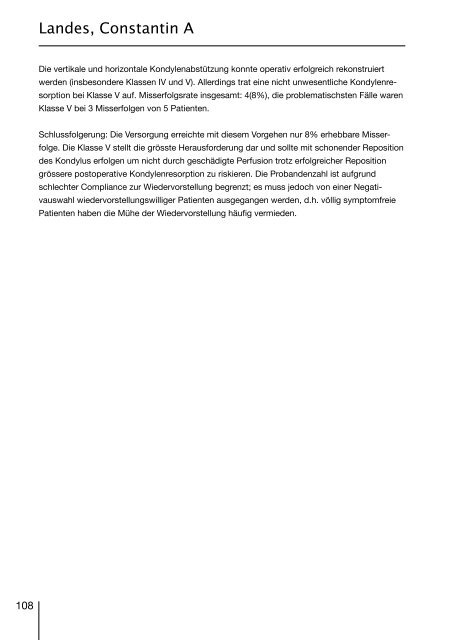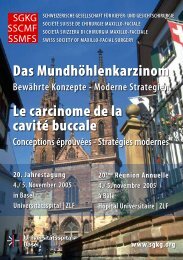ÖGMKG - und Gesichtschirurgie
ÖGMKG - und Gesichtschirurgie
ÖGMKG - und Gesichtschirurgie
Sie wollen auch ein ePaper? Erhöhen Sie die Reichweite Ihrer Titel.
YUMPU macht aus Druck-PDFs automatisch weboptimierte ePaper, die Google liebt.
Landes, Constantin A<br />
Die vertikale <strong>und</strong> horizontale Kondylenabstützung konnte operativ erfolgreich rekonstruiert<br />
werden (insbesondere Klassen IV <strong>und</strong> V). Allerdings trat eine nicht unwesentliche Kondylenre-<br />
sorption bei Klasse V auf. Misserfolgsrate insgesamt: 4(8%), die problematischsten Fälle waren<br />
Klasse V bei 3 Misserfolgen von 5 Patienten.<br />
Schlussfolgerung: Die Versorgung erreichte mit diesem Vorgehen nur 8% erhebbare Misser-<br />
folge. Die Klasse V stellt die grösste Herausforderung dar <strong>und</strong> sollte mit schonender Reposition<br />
des Kondylus erfolgen um nicht durch geschädigte Perfusion trotz erfolgreicher Reposition<br />
grössere postoperative Kondylenresorption zu riskieren. Die Probandenzahl ist aufgr<strong>und</strong><br />
schlechter Compliance zur Wiedervorstellung begrenzt; es muss jedoch von einer Negati-<br />
vauswahl wiedervorstellungswilliger Patienten ausgegangen werden, d.h. völlig symptomfreie<br />
Patienten haben die Mühe der Wiedervorstellung häufig vermieden.<br />
Beck-Mannagetta, Johann<br />
Radiodense „concrements“ in colonizing aspergillosis of the maxillary<br />
sinus consist of extruded endodontic sealer (Poster 06-14)<br />
Johann Beck-Mannagetta 1, Gernot Friedbacher 2, Elisabeth Eitenberger 2 (j.beck-mannaget-<br />
108 109<br />
ta@salk.at)<br />
(1) Clinic of Oral & Maxillofacial Surgery/SALK, Müllner Hauptstr. 48, A-5020 Salzburg (2) Inst. f.<br />
Chemical Technologies and Analytics, Div. of Instrumental Analytical Chemistry/TU, Getreide-<br />
markt 9/164-IAC, A-1060 Wien<br />
Backgro<strong>und</strong> : Radiopaque „concrements“ have been described as being characteristic for<br />
colonizing aspergillosis of the maxillary sinus (CAMS). The aim of this retrospective study is to<br />
investigate the origin of these particles.<br />
Patients and methods : The records of 104 patients with the histopathological diagnosis of<br />
CAMS operated at the Clinic of Oral & Maxillofacial Surgery reviewed. Age, sex, symptoms and<br />
radiology were documented.- The retrieved „concrements“ of 66 patients were analyzed by en-<br />
ergy-dispersive x-ray analysis at the Div. of Instrumental Analytical Chemistry, Vienna University<br />
of Technology. Four commercially available sealers were analyzed for comparison.<br />
Results : Age ranged from 18 to 89 years (mean 42 yrs.); 77 patients were female, 27 male.<br />
Symptoms ranged from none to severe sinonasal infection. On radiographs 83 patients reve-<br />
aled a small sharply delineated radiodense particle within the maxillary sinus. In 21 patients<br />
no „concrement“ could be observed. In 66 patients the material could be analyzed: It was<br />
consistent with the endodontic sealers Endomethasone (38x), Riebler´s Paste (13x), N2 (6x)<br />
and AH26 (2x). In seven cases the material could not be attributed to a specific sealer but the<br />
artificial origin was beyond doubt.<br />
Conclusions : Our clinical, radiographic and analytical findings confirm a close correlation of<br />
CAMS and extruded endodontic sealer. Due to the very different composition of these sealers<br />
it seems that the heavy elements (causing the radiopacity) are not directly leading to CAMS.<br />
Other possibly causative factors (e.g. cytotoxic components of the sealer, local tissue necrosis<br />
or inhalation of organic dust) or spontaneous loss of the foreign body via the nasal orifice have<br />
to be considered. In all these patients a high concentration of zinc ions from the sealer may<br />
promote the growth of aspergillus spores and lead to the typical radiographic appearance of<br />
CAMS.



